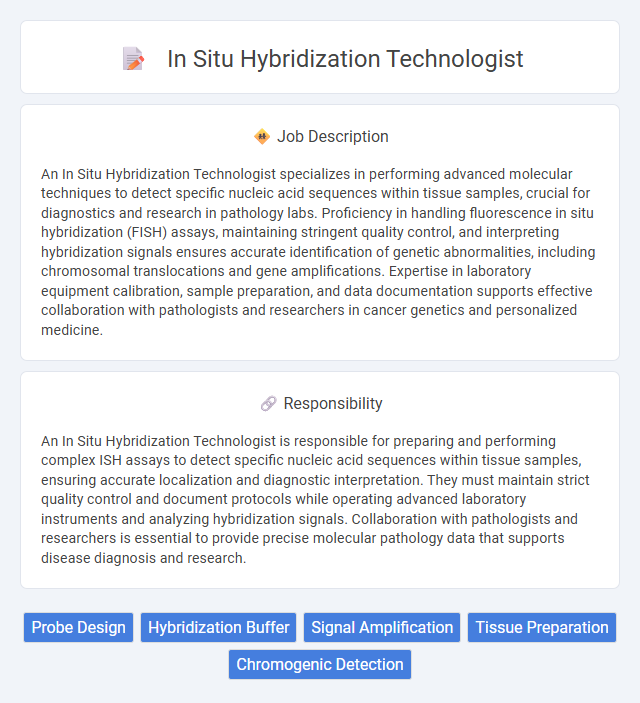
An In Situ Hybridization Technologist specializes in performing advanced molecular techniques to detect specific nucleic acid sequences within tissue samples, crucial for diagnostics and research in pathology labs. Proficiency in handling fluorescence in situ hybridization (FISH) assays, maintaining stringent quality control, and interpreting hybridization signals ensures accurate identification of genetic abnormalities, including chromosomal translocations and gene amplifications. Expertise in laboratory equipment calibration, sample preparation, and data documentation supports effective collaboration with pathologists and researchers in cancer genetics and personalized medicine.
Individuals with strong attention to detail and an interest in molecular biology are likely suitable for an In Situ Hybridization Technologist role. Those who can work in a controlled, laboratory environment and manage repetitive tasks with precision might find this job fitting. Candidates prone to workplace distractions or discomfort with technical procedures may have difficulty thriving in this position.
Qualification
In Situ Hybridization Technologists typically require a bachelor's degree in molecular biology, biotechnology, or a related life science field, with extensive knowledge of nucleic acid hybridization techniques. Proficiency in laboratory procedures, including sample preparation, probe labeling, and fluorescence microscopy, is essential for accurate detection of RNA and DNA sequences in tissue samples. Certification or hands-on experience with automated in situ hybridization platforms and strong analytical skills further qualify candidates for this specialized laboratory role.
Responsibility
An In Situ Hybridization Technologist is responsible for preparing and performing complex ISH assays to detect specific nucleic acid sequences within tissue samples, ensuring accurate localization and diagnostic interpretation. They must maintain strict quality control and document protocols while operating advanced laboratory instruments and analyzing hybridization signals. Collaboration with pathologists and researchers is essential to provide precise molecular pathology data that supports disease diagnosis and research.
Benefit
In Situ Hybridization Technologists likely experience benefits such as enhanced expertise in molecular diagnostics and exposure to cutting-edge laboratory techniques. There is a probable increase in career opportunities within clinical and research settings due to specialized skill sets. Improved precision in disease diagnosis and personalized medicine approaches may also contribute to job satisfaction and professional growth.
Challenge
Working as an In Situ Hybridization Technologist likely involves navigating complex protocols requiring precise technical skills and attention to detail. There is a probability of encountering challenges related to optimizing hybridization conditions to achieve accurate and reproducible results. Managing potential variability in sample quality could further complicate the interpretation and reliability of diagnostic data.
Career Advancement
In Situ Hybridization Technologists gain expertise in advanced molecular biology techniques essential for diagnosing genetic disorders and cancers, positioning themselves for specialized roles in clinical laboratory management or genetic research. Proficiency in analyzing and interpreting hybridization results accelerates career progression to supervisory or lead technologist positions, often accompanied by certifications such as ASCP. Continuous professional development in emerging ISH technologies and bioinformatics tools enhances opportunities in translational research, personalized medicine, and biotechnology sectors.
Key Terms
Probe Design
In Situ Hybridization Technologists specializing in probe design develop highly specific nucleic acid probes to detect target RNA or DNA sequences within tissue samples, ensuring accurate localization and visualization of genetic material. They utilize bioinformatics tools and databases to optimize probe specificity and sensitivity, minimizing cross-hybridization and background noise. Expertise in molecular biology techniques and probe labeling strategies is essential to enhance diagnostic precision in research and clinical applications.
Hybridization Buffer
The In Situ Hybridization Technologist expertly prepares and applies hybridization buffer to facilitate the precise binding of nucleic acid probes to target sequences within tissue samples. This specialized buffer maintains optimal pH and salt concentration, enhancing probe-target hybridization efficiency and signal specificity. Mastery in formulating and handling hybridization buffer is critical for achieving accurate and reproducible molecular diagnostics results.
Signal Amplification
In Situ Hybridization Technologists specialize in detecting specific nucleic acid sequences within tissue samples using advanced signal amplification techniques to enhance sensitivity and accuracy. They utilize amplification systems such as branched DNA or tyramide signal amplification to increase probe detection, enabling the identification of low-abundance RNA or DNA targets critical for diagnostic and research purposes. Mastery of these amplification methodologies ensures precise localization and quantification of genetic material, essential for molecular pathology and personalized medicine applications.
Tissue Preparation
In Situ Hybridization Technologists specializing in tissue preparation expertly handle embedding, sectioning, and slide mounting to preserve tissue morphology and nucleic acid integrity for accurate probe hybridization. They utilize precision microtomy techniques and optimized fixation protocols to ensure sample quality, enabling sensitive and specific signal detection in gene expression analysis. Mastery of tissue preparation directly impacts diagnostic reliability and research outcomes in molecular pathology and genomics.
Chromogenic Detection
In Situ Hybridization Technologists specializing in chromogenic detection perform precise localization of nucleic acid targets within tissue samples, utilizing chromogenic substrates to produce visible colorimetric signals. This technique enhances diagnostic accuracy in detecting genetic abnormalities and infectious agents by leveraging enzyme-mediated color changes for microscopic analysis. Proficiency in assay optimization, tissue processing, and quality control ensures reliable and reproducible chromogenic ISH results critical for pathology and research applications.
 kuljobs.com
kuljobs.com